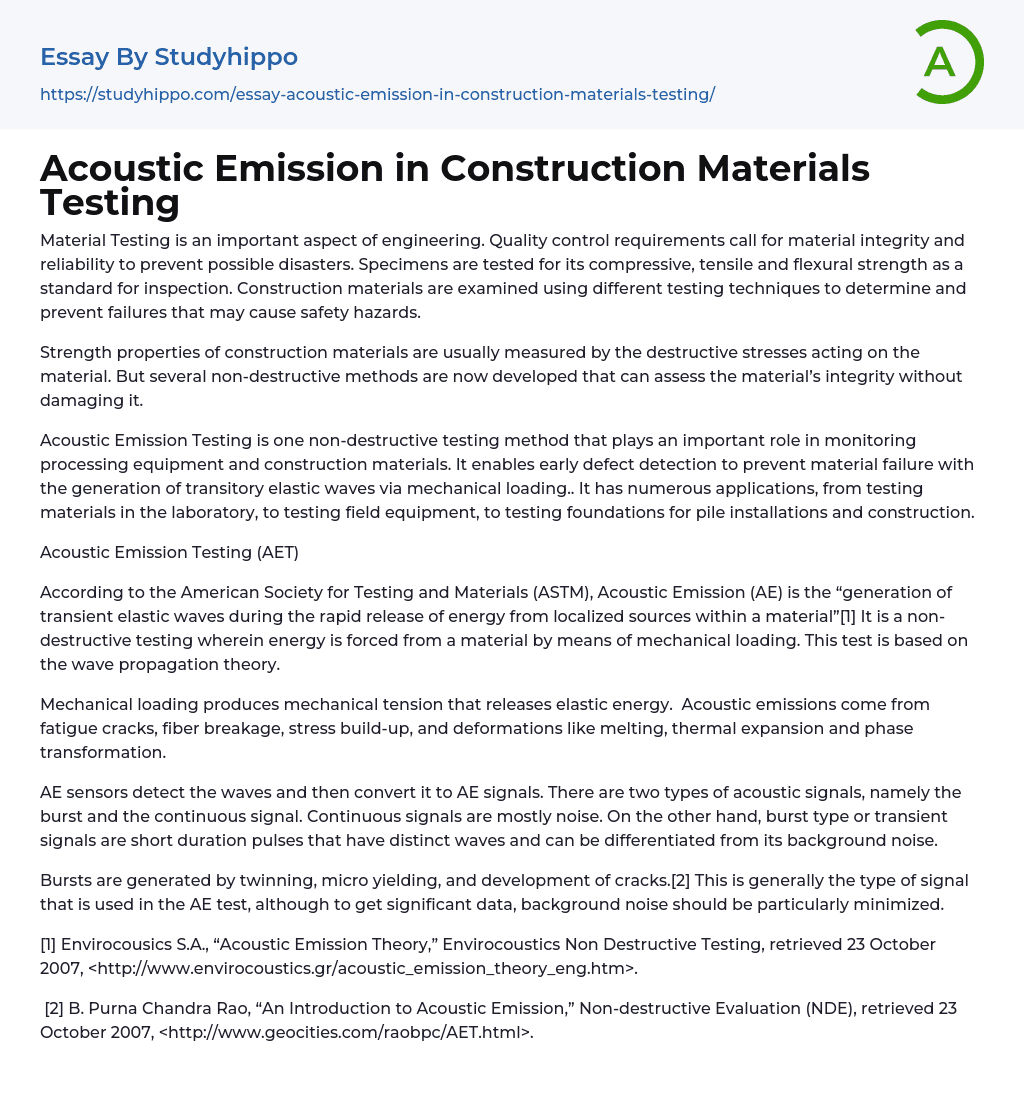

Acoustic Emission in Construction Materials Testing Essay Example
Material Testing plays a vital role in engineering and ensures the integrity and reliability of materials to avoid potential disasters. Various inspection standards require testing specimens for their compressive, tensile, and flexural strength. Through different testing techniques, construction materials are thoroughly examined to identify and prevent failures that could pose safety hazards.
Unified Text
Construction materials are typically evaluated for their strength using destructive stress tests. However, there are now non-destructive techniques available that can evaluate the material's integrity without any harm.
Acoustic Emission Testing is a vital non-destructive testing method used to monitor processing equipment and construction materials. It plays a crucial role in early defect detection and preventing material failure by generating transitory elastic waves through mechanical loading. The application of this method extends across variou
...s areas, from laboratory material testing to field equipment testing, as well as foundation and construction testing for pile installations.
The technique being used is Acoustic Emission Testing (AET).
The generation of short-lived elastic waves when energy is swiftly released from certain sources within a material is known as Acoustic Emission (AE) according to the American Society for Testing and Materials (ASTM)[1]. AE is a non-destructive testing approach that relies on mechanical loading to extract energy from a material, based on wave propagation theory.
Mechanical loading creates mechanical tension which leads to the release of elastic energy. Acoustic emissions originate from various sources such as fatigue cracks, fiber breakage, stress accumulation, and deformations including melting, thermal expansion, and phase transformation.
AE sensors identify waves and transform them into AE signals. These signals can be classified as burst or
continuous. Continuous signals typically represent noise, whereas burst signals are brief pulses exhibiting distinctive wave patterns that can be differentiated from surrounding background noise.
Bursts are produced through twinning and micro yielding, as well as the formation of cracks. These signals are typically used in the AE test but require minimizing background noise to obtain meaningful data.
[1] Envirocousics S.A. provides information on the theory of acoustic emission in non-destructive testing. The information can be found at the Envirocoustics Non Destructive Testing website, accessed on 23 October 2007 at http://www.envirocoustics.gr/acoustic_emission_theory_eng.htm.
[2] B. Purna Chandra Rao offers an introductory article on acoustic emission in the non-destructive evaluation field. The article is available at http://www.geocities.com/raobpc/AET.html. Retrieved on 23rd October 2007.
- Organic Chemistry essays
- Acid essays
- Calcium essays
- Chemical Bond essays
- Chemical Reaction essays
- Chromatography essays
- Ethanol essays
- Hydrogen essays
- Periodic Table essays
- Titration essays
- Chemical reactions essays
- Osmosis essays
- Carbohydrate essays
- Carbon essays
- Ph essays
- Diffusion essays
- Copper essays
- Salt essays
- Concentration essays
- Sodium essays
- Distillation essays
- Amylase essays
- Magnesium essays
- Acid Rain essays
- Building essays
- Agriculture essays
- Albert einstein essays
- Animals essays
- Archaeology essays
- Bear essays
- Biology essays
- Birds essays
- Butterfly essays
- Cat essays
- Charles Darwin essays
- Chemistry essays
- Dinosaur essays
- Discovery essays
- Dolphin essays
- Elephant essays
- Eli Whitney essays
- Environmental Science essays
- Evolution essays
- Fish essays
- Genetics essays
- Horse essays
- Human Evolution essays
- Isaac Newton essays
- Journal essays
- Linguistics essays



